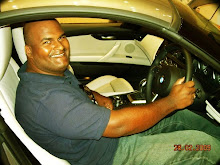REVIEW: Fuji FinePix S9000
FinePix S9000
Fuji Photo Film USA Inchttp://www.fujifilm.com 
Type: Superzoom
Megapixels: 9
Included Memory Amount: 16 MB
Included Memory: Media Card
Media Format: xD-Picture Card
Battery Type Supported: AA
Included Batteries: Yes
35-mm Equivalent (Wide): 28
35-mm Equivalent (Telephoto): 300
Maximum Resolution: 3488 x 2616 pixels
Interface: USB 2.0
Video Capture Ability: Yes
$505.00 - $700.00
By Terry Sullivan
In addition to offering some of the benefits you get from a D-SLR, the Fuji FinePix S9000 has a 10.7X optical zoom lens—better than what's included in most D-SLR kits. But the S9000 has some stiff competition in the Panasonic Lumix DMC-FZ30, our current Editors' Choice for superzooms. Although priced the same ($650 street), the S9000 can't quite match the outstanding quality, performance, and ease of use of the FZ30.
The two cameras look roughly the same, but the S9000 is a bit smaller and lighter. We certainly like the overall look of the newcomer, which has two manual rings around the lens barrel: one for zoom and one for focus. Although the S9000, like our Editors' Choice, gave us precise control as we zoomed in and out on a subject, it sometimes failed to focus quickly enough—or at all—when we used the manual focus ring. We like the feature, but it needs to be better implemented. In addition, the 1.8-inch LCD is small in today's market.
As with the FZ30, the S9000's hot shoe, which lets you attach an auxiliary strobe light, is dumb. It doesn't support two-way communication between the flash and the camera.
The high-resolution sensor is big enough to allow large prints or generous cropping using image-editing software. But as a superzoom, the camera doesn't get quite as close to the action as the FZ30 with its 12X optical zoom.
At 10.7X optical zoom, the S9000 has a 6.2mm to 66.7mm zoom (a 35-mm equivalent of 28mm to 300mm) with a maximum f/stop range of f/2.8 to f/4.9 across the zoom range. The wide-angle end of the zoom range is fine, but at the telephoto end, the maximum aperture, at f/4.9 is not quite as good as the FZ30's f/3.7.
Although we saw very little noise in our simulated-daylight and flash test shots, it became more noticeable as we went up to 1,600 ISO. Color matching and vibrancy was as good as the FZ30's and superior to the color casts we got using the FZ20, with just a bit of fringing in the image. The simulated-daylight shot had pretty good exposure, with very good dynamic range, but highlights were slightly blown out. We also didn't quite see a true black in the shots.
The FZ30 and FZ20 had better sharpness and stronger contrast. Flash coverage from the S9000 was just right, though, so our still life was properly exposed without any blown-out highlights. Because of the flash, the image exposure was exactly on target.
Resolution testing produced an average score 1,700 lines, which is our lowest acceptable threshold for an 8MP camera—unfortunately, Fuji bills the camera as a 9MP. In fact, the 8MP FZ30 actually had a slightly higher score, at 1,775.
In our performance tests, the S9000 was quick to boot, taking just 2.4 seconds, and had a 3.1-second recycle time, which was also quite good. That said, neither score was quite as good as the FZ30's. We saw almost no shutter lag, though, and found very little distortion at the wide-angle end of the zoom range with none at the telephoto end of the range.
The S9000 offers two scene modes to reduce the blur that results from shaky hands (or subjects): An Anti Blur mode, which you can use with the pop-up flash, and a Natural Light mode, which disengages the flash. The combination doesn't work as well as the Panasonic FZ30 Mega O.I.S. system, but in our testing, both modes were reasonably effective.
The modes work by increasing the ISO, which lets the camera use a faster shutter speed to reduce the effect of the subject or photographer moving.
The downside is that the photos display more noise—the speckled dots that may appear in your photo's darker tones. On 4-by-6 or 5-by-7 prints, you won't notice much. But if you plan on making large prints, you might need image-editing software to reduce some of the noise.
The S9000 shoots MotionJPEG video at 640-by-480 and 30 frames per second until the memory card is full. The colors in our video clips were vibrant and the autofocus quickly adjusted to both exposure and zoom changes. In video mode, the zoom ring is great for accurately and silently zooming. The only noise you're likely to hear is the slight swoosh and click as the zoom lens reaches its wide-angle and telephoto maximum ranges.
Overall, the Fuji FinePix S9000 is a well-rounded, full-featured superzoom. It falls just short of an Editors' Choice, leaving the Panasonic Lumix DMC-FZ30 with that honor.
Source:pcmag









0 Comments:
Post a Comment
<< Home